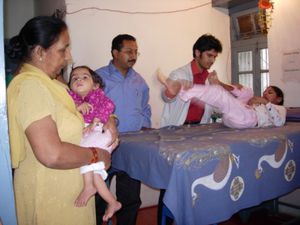In order to give you a glimpse of what happens in the Handimachal Unit on a daily basis, I have requested Mayur, our new physiotherapist, to introduce part of his activity in relation to some selected children who are representatives of the many disability cases of children in Kullu district.
 |  |
Name: Tavleen (girl, 1 year old)
Diagnosis: cerebral palsy with delayed mile stone. Premature child (by 28 days) and joundice after 3 days.
Tavleen was reffered to the Handimachal Unit by Mission Hospital Manali for physiotherapy treatment. When we first assessed her on 17 May 2011, Taveleen was not able to move her arms and legs, could not use her hands for grasping things and there was no neck and trunk control. After 10 regular sessions of physiotherapy, Taveleen improved and started doing little movements with arms and legs. Since the beginning of June, Tavleen’s parents have brought her to the Unit every day for treatment.
For the moment, physiotherapy treatment consists in passive movements, mobilisation techniques and PNF (proprioceptive neuromuscular fascilation) patterns. Considering Taveleen’s very young age, speech therapy is not possible yet, although necessary, but in the meantime the parents have been advised to stimulate lip strengthening to make bilabial sounds possible.
 |  |
Name: Aslam (boy, 1 year old)
Diagnosis: cerebral palsy with delayed milestones and squint eyes.
Aslam is again a premature delievery child who suffered jaundice 2 days after birth. When we first assessed this little boy on 12 May 2011, he had no neck or trunk control and, although he has the grasping reflex, he is not performing much active movements. Aslam has been brought to the Unit regularly by her mother in June, and his ability to performed active movements seems to be improving.
Aslam’s physiotherapy treatment focusses on passive movements, PNF (Proprioceptive Neuromuscular fascilation) patterns, exercices on physio ball and prone lying activities.
As for Tavleen, the mother has been shown how to perform some basic physiotherapy exercices to be done at home twice a day. She was also advised to consult an eye specialist regarding the strong dilatation.
The arrival of our next occupational therapist will also increase activity stimulation for both children in order to break natural barriers already developed by Tavleen and Aslam.
 |  |
Name: Sabina (girl, 10 years old)
Diagnosis: cerebral palsy with mental retardation. According to parents, forceps delivery caused injury to the brain.
Sabina has been benefiting treatment in the Handimachal Unit twice a week since beginning of September 2010. When she first visited the Unit she had lots of contractures in ankle, foot and in hands. She was not able to sit, stand nor walk actively. Most of her moves are stereotypies, resulting from archaic motricity (no sense moves, throwing, table hitiing, hands bitting...) although there seems to be no physical obstacle to the voluntary moves. Sabina can hear and follows with eyes and head, but does not talk and salivates a lot. She likes music but her mood is quite unstable.
Thanks to regular visits in the Handimachal Unit, the physiotherapy treatment seems to be improving the girl’s physical situation, decreasing contractures in ankle, foot and hands. Now Sabina has started sitting actively for some time. Due to mental retardation, Sabina’s improvement is very slow but her parents are happy and satisfied with physiotherapy treatment.
As far as speech therapy interventions are concerned, Ajay’s goals are to put Sabina onto a non-verbal mode of communication, use a communication board and improve her vegetative functions. Speech stimulation exercises have been given lately with limited results up to now.
No doubt that the involvement of our next occupational therapist, further to Catriona and Sara’s patient efforts to develop her autonomy, stimulate balancing, improve communication, increase voluntary moves by making them have a sens (catch, touch, not just throwing, etc.), will also positively impact Sabina’s life.
 |  |
Gathering of children with their parents in the Unit. Since the end of winter, 6 to 7 children come regularly for treatment and one of the main challenges is of course to continue motivating parents to bring children to the Unit very regularly, even if positive results cannot be seen day by day – and also to give them the discipline of coming on fixed appointments and not when they feel free to come so that they do not waste their time in the waiting room of the Unit...
Thank you Mayur for providing clinical information on children and also Ramneek for taking pictures!


